Most mental health professionals would agree that if one could assign DSM V criteria to elements, zinc's diagnosis would be easy:
Code F31.9, Bipolar I disorder, current or recent episode unspecified.
There are a few reasons that I believe this diagnosis is valid, and I will discuss them below. First, the fun stuff. The minerals in which zinc is found are both fascinating and spectacular.
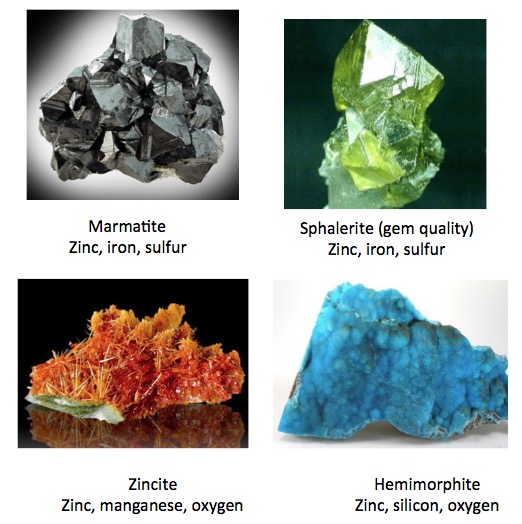
Selected zinc-containing minerals. Photos: 1. 911 Metallurgist 2. Geology.com 3. pierresdesante.com 4. Heavencanwaitgifts.
So, it is accurate to say that zinc is "bipolar?" In a chemical sense, it is just that. Here are the reasons.
1. IT HELPS AND HARMS US
Help
Zinc is found in metalloproteinases, a subset of a huge family of enzymes called proteinases (1) (also called proteases). Protease enzymes require the metal to promote a wide variety of biochemical reactions that are necessary for life. Zinc is considered to be an essential nutrient for humans, but the exact reason is not known.
Harm
Bacteria also use zinc, but for a different reason - to keep from being poisoned. It is responsible for one of the best-known (and most common) mechanisms of bacterial resistance - zinc metalloproteinase-catalyzed beta-lactam ring opening. In English: bacteria use zinc plus enzymes to detoxify beta-lactam antibiotics, such as penicillins and cephalosporins. They do so in a very clever way. (Figure 1)
But first...
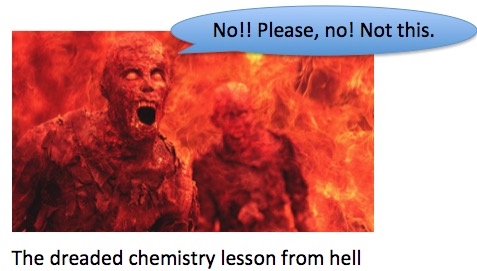
Original image: Disclose TV
For metalloproteinases to function, zinc is essential. It performs two tasks: 1) helping the beta-lactam antibiotic to bind more tightly at the metalloproteinase active site, 2) helping the metalloproteinase chemically destroy the antibiotic. Here are the details:
After the antibiotic has bound to the enzyme, the zinc atom which helped it bind has other functions. Zinc binds to a water molecule and holds it in close proximity to beta-lactam part of the antibiotic. This greatly facilitates the ability of water to react with the beta-lactam. Second, zinc acts as a catalyst to break open the beta-lactam, a four-membered ring, which is the "business end" of the antibiotic. Once the ring is opened the antibiotic is no longer an antibiotic.
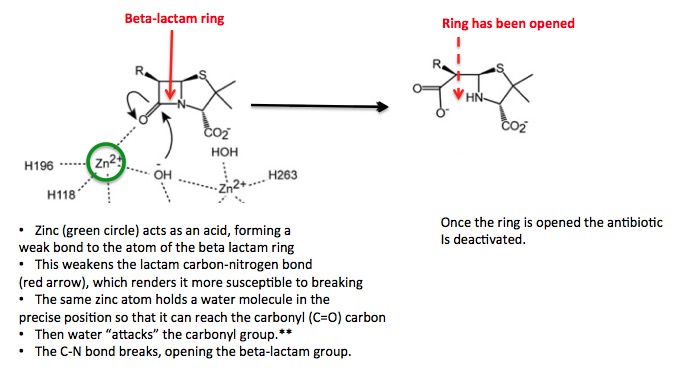
Figure 1. The role of zinc in deactivating beta-lactam antibiotics. **It's actually a bit more complex than this. Water exists partially ionized as H+ and OH-. The zinc atom stabilizes the OH- (hydroxyl) group, which is much more reactive. The hydroxyl ion is the actual attacking species.
2. ZINC COMPOUNDS CAN BE ACIDIC OR BASIC
1. Basic
Zinc metal reacts with hydrochloric acid to form zinc chloride. When the solution is neutralized, zinc hydroxide, an insoluble white precipitate forms. Zinc hydroxide is amphoteric, meaning that it reacts with either acids or bases. So, if you add more hydrochloric acid to the tube with the white precipitate it will be converted back to water-soluble zinc chloride. In this case, zinc hydroxide is acting as a base (it reacts with an acid). (Figure 2)
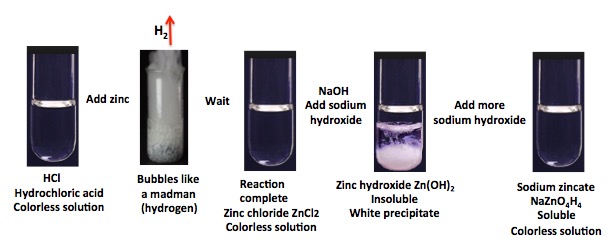
Figure 2. The amphoteric nature of zinc hydroxide
2. Acidic
But instead of adding hydrochloric acid, if you add even more sodium hydroxide, the same physical change is noted, but for a different reason. In this case, the zinc hydroxide acts as an acid, reacting with the sodium hydroxide (base) to form another compound, sodium zincate. Since sodium zincate is soluble in water the precipitate again dissolves, giving a clear, colorless solution (1). Oxides or hydroxides of a few other metals are also amphoteric. The first tube and the last tube in this experiment should look the same- a colorless, clear liquid.
ZINC CAN BE EITHER A STABLE METAL OR A GAS THAT BURSTS INTO FLAME IN AIR
1. Elemental zinc - a stable metal
Elemental zinc is chemically unreactive compared to many other metals, enough so that it can be found in the ground. But it is reactive enough to be susceptible to attack by strong acids, such as hydrochloric acid, as shown above.
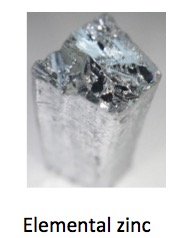
Elemental zinc, nice and stable. Photo: ScienceMadness
2. Organometallic zinc - a psychotic, colorless, volatile liquid or gas
On the other hand, organometallic zinc compounds - those in which the zinc is chemically bound to carbon - are quite different. The common organometallic zinc compounds are volatile liquids or gases. And they are in a perpetually bad mood. The photo below shows what happens if you allow dimethylzinc to come into contact with air. Dimethylzinc is one of the infamous chemicals that chemistry blogger Derek Lowe has included in his wildly popular "Things I Won't Work With" feature.
"But neat dimethyl zinc. . .no, I don’t think so. A colleague of mine made some in graduate school, and came down the hall to us looking rather pale. He’d disconnected a length of rubber tubing from his distillation apparatus and seen it go up in immediate, vigorous flames. 'This stuff makes t-butyllithium look like dishwater' is the statement I remember from that evening." (3)
Derek Lowe. In the Pipeline
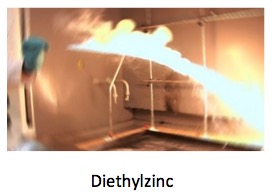
Diethylzinc plus air. Don't try this at home. Photo: YouTube
MISCELLANEOUS FACTS ABOUT ZINC
- Zinc was discovered by Paracelsus in (4)
- Pennies were 95% copper until 1982 when the mint changed the composition to 97.5% zinc. If it had not done so, a penny would be worth about $.02 just for the copper, so people would hoard them for the "melt value." If you can even find a pre-1982 penny in circulation, hold it in your hand. Then hold the zinc penny. You will be able to tell that the new pennies are considerably lighter; 3.1 grams for the copper penny and 2.5 g for the zinc penny. This is because of the relative density of the two metals; 8.96 for the copper penny and 7.13 g/mL for the zinc penny. Copper is 25% denser than zinc; the copper penny weighs 24% more than the zinc penny. This is no coincidence.
- "Dr." Axe claims the zinc is natural cancer treatment. "Dr." Axe also sells zinc. Probably a coincidence. Dr. Axe is also one flipped out dude.
- Zinc either prevents/treats colds or it doesn't. But if you suck on too many zinc lozenges you could permanently lose your sense of smell. Not so bad for subway riders. Otherwise, not recommended.
NOTES:
(1) Proteases (aka proteinases) are a huge class of enzymes which function by breaking down (digesting) proteins to give smaller proteins or even further to give the individual amino acids that make up proteins. Proteases are ubiquitous. For example, there are now drugs that inhibit the proteases that play an essential part in the life cycle of HIV and hepatitis C. When a viral protease is inhibited the virus cannot replicate. This inhibition is the basis for many of the highly effective drugs for HIV and hepatitis C.
(2) Non-chemists usually don't know what "clear" means. Clear does not mean colorless. It means that light can pass unobstructed through the solution. A green solution made by adding food dye to water will be clear, but not colorless. All solutions are clear.
(3) See Butyllithium — Something You Really Don't Want To Mess With
(4) Paracelsus is badass. Not only did he discover zinc in 1526, but he also became the father of modern toxicology by coining the expression "the dose makes the poison. Sort of. What he actually wrote was that "All things are poison and nothing is without poison; only the dose makes a thing not a poison." Same thing. Yet, here we are 5+ centuries later and NY Times columnist Nick Kristof, who writes about toxicity, hasn't caught up to the 15th century yet. He is absolutely convinced that the dose does not make the poison. Nor did he discover zinc.




